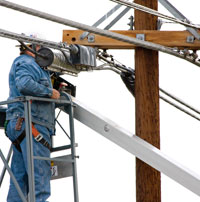Aerial Lift Safety
October 02, 2018
 Cherry pickers, bucket trucks, vertical towers, and aerial ladders all fall under the category of aerial lifts. The most common uses for aerial lifts are in telephone, transmission and cable line work. Aerial lifts give workers easier line access and allow them to carry tools for maintenance, installation, replacement, and repair work. Workers use the lifts to wash outside windows and paint walls on tall buildings. They can also be used to harvest fruit, prune tall trees, and for other construction and maintenance purposes.
Cherry pickers, bucket trucks, vertical towers, and aerial ladders all fall under the category of aerial lifts. The most common uses for aerial lifts are in telephone, transmission and cable line work. Aerial lifts give workers easier line access and allow them to carry tools for maintenance, installation, replacement, and repair work. Workers use the lifts to wash outside windows and paint walls on tall buildings. They can also be used to harvest fruit, prune tall trees, and for other construction and maintenance purposes.
Individuals who work on aerial lift devices are subject to a specific set of hazards that they should be aware of. The main safety risks for aerial left workers include falls, tip-overs, getting stuck in-between the bucket and an object, and electrocutions, which can all be fatal. The Center for Construction Research and Training reported that dozens of workers are fatally injured every year on aerial lifts.
Aerial Lift Accident Prevention
Workers should be in sync with their supervisors when it comes to aerial lift safety measures. Before work starts, the lift’s operating system and emergency mechanisms must be inspected thoroughly. There should be no broken or missing parts, and the controls should be marked clearly. The area where the lift is used must be inspected as well. Surfaces must be stable and level, and hazards like power lines and other obstructions should be carefully noted. All workers should be well trained and experienced with the specific aerial lift models that they will be using. They should also wear proper protection equipment.
Power Line Safety
The lift and any objects that conduct electricity should be at least 10 feet away from power lines. Objects include pipes, wires, transformers, and other types of equipment. Even if the aerial lift bucket is insulated, it may not completely protect the worker.
Fall and Tip-Over Protection
Workers should wear either full-body safety harnesses or positioning devices while on the lift. These should be used with a lanyard and attached onto the basket or boom. This safety measure can stop them from being pulled or ejected. It is also important for workers to stand firmly on the lift basket’s floor, and to never sit or move onto its edges or rails. Tip-overs can be prevented by not driving when the vehicle’s lift platform is up, unless the lift was designed for this type of work.
Struck-By Prevention
The work area must be set up to alert others of its presence. A clearly marked danger zone around the vehicle will let others know to keep a good distance. In addition, the workers should never be positioned in-between overhead dangers, like beams and the basket’s rails. This could cause them to get trapped or crushed if the basket moves.
Philadelphia Construction Accident Lawyers at DiTomaso Law Help Injured Construction Workers
Aerial lift incidents are only one type of construction accident. If you or someone you care about has been injured on a construction site, contact the experienced Philadelphia construction accident lawyers at DiTomaso Law. We offer free consultations to discuss your case. Contact us at 215-426-4493 or complete our online form. We are in Philadelphia, and we proudly serve clients from the surrounding areas.

Get A 100% Free Case Evaluation
From A Top-Rated Personal Injury Attorney
Call: 856-414-0010 or Chat Live Now
$11.7M
Tractor-Trailer Accident
$1.5M
Drunk Driving Accident
$1.3M
Defective Machinery Accident
01
02
03
04

